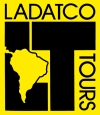

Destinations
Experiences
 |
L A
D A T C O T O U R
S |
 |
||||||||
| HOME | South America | Falkland Islands | Antarctica | Unique Destinations |
Unique Experiences |
Newsstand | ||||
Uruguay- General Information |
| General information on Uruguay from the official government web site of Uruguay. |
Total Surface: 313,782 km2
Population: 3,151,662 (data 1996)
Capital: Montevideo
Language: Spanish
Political regime: Republican Democracy
Currency: Uruguayan Peso
Average temperatures: Spring: 17°C , Summer: 23°C, Autumn: 18°C , Winter: 12°C
Cultural Profile: Literacy: 96.2%, Students per teacher: 21
Official Educational System: lay, free and compulsory
Religion: Catholic 56.2% - Non religious 38.3% - Protestant 2% Jewish: 1.7%Geographical Location
The Oriental Republic of Uruguay is located in South America. Its eastern coast is on the Atlantic Ocean, between parallels 30º and 35° of South latitude and meridians 53°and 58° West longitude. It is thus located in the temperate area of the Southern Hemisphere, with sea predominance. The Oriental Republic of Uruguay is named after its geographic location to the east of the Uruguay River. This geographical reason as well as historical reasons caused the Uruguayans to be called 'Orientals', even if, obviously, Uruguay is situated in the Western Hemisphere. As for the word 'Uruguay', it comes form the Guarani language, meaning 'river where the birds live'.Territorial Surface
The Uruguayan territory covers 176,215 Km2. It is a small country if compared to its large neighbors or to other American states, but in comparison to countries in other parts of the world, Uruguay is larger in size than many European and Central American countries, since its surface equals that of the Netherlands, Denmark and Switzerland put together. Furthermore, its territory is completely habitable, there are no barren areas and 90% of its surface is profitable. Apart from the territorial extension Uruguay has a total area of 120,684 Km2 of territorial sea, plus the jurisdictional waters of its important rivers and lakes.Climate
Uruguay’s location in the Austral Temperate Zone of the Southern Hemisphere gives it a mild climate. The average temperature in Spring is 17°C; in Autumn 18° and in Winter 12°. The extreme temperatures reach, as an exception, 40° in the Summer and 2° or 3° below zero in Winter. There are many sunny days in the year but the sudden changes in the weather are quite frequent. The winds blow mainly from the north, humid and hot and the Pamper and Southern winds are cold and dry.Population
The population of Uruguay is of European origin, basically Spanish and Italian but there are other nationalities, due to the country’s open doors policy. There is also a small presence of the black race which arrived to our country from the coasts of Africa at the times of the Spanish domination. Regarding the indigenous population, the last remaining Indians disappeared from our national territory more than one century ago, this meaning a great difference between the Uruguayan population and the population of the rest of the Latin American countries.
The last population census determined the population in Uruguay is 2.940.300 inhabitants. This, translated into the number of people per square kilometer, says our country has a low density. However, even if Uruguay is an agricultural country, its population is essentially urban (80%) and 43% is concentrated in Montevideo. Its birth rate is low, the lowest in Latin America but the life expectation is very high: 72 years for men and 74 for women, showing the high sanity and nutrition standards.
The Uruguayan people enjoy a high cultural level, they are open and solicitous to the visitors, of simple and familiar habits, lovers of life in the open air and of sports, mainly football, the national sport and the national passion. Regarding the taste in food, the famous "churrasco" (beef steak) and “asado con cuero” (grilled beef with the skin) of excellent Uruguayan beef are the favorites.Education
The Uruguayan official educational system offers lay, free and compulsory education. This has been so ever since 1877 for Primary Education, the Secondary Education was later made compulsory and the university studies are for free. Regarding laity, private institutes offer religion. One of the most outstanding achievements of our educational system is that it reaches 94% of the children over the age of 10.Government
Uruguay has adopted the democratic republican form of government under a presidential system, dividing the State in the classical three powers: Executive, Legislative and Judicial. According to the present Constitution, the Uruguayan people, lover of liberty and democracy, chooses the authorities that shall rule the country.Religion
The Uruguayan Constitution guarantees the religious freedom, hence, there are many religions in the country. However, the Catholic religion has been present all through the country’s history and is predominant in the population.